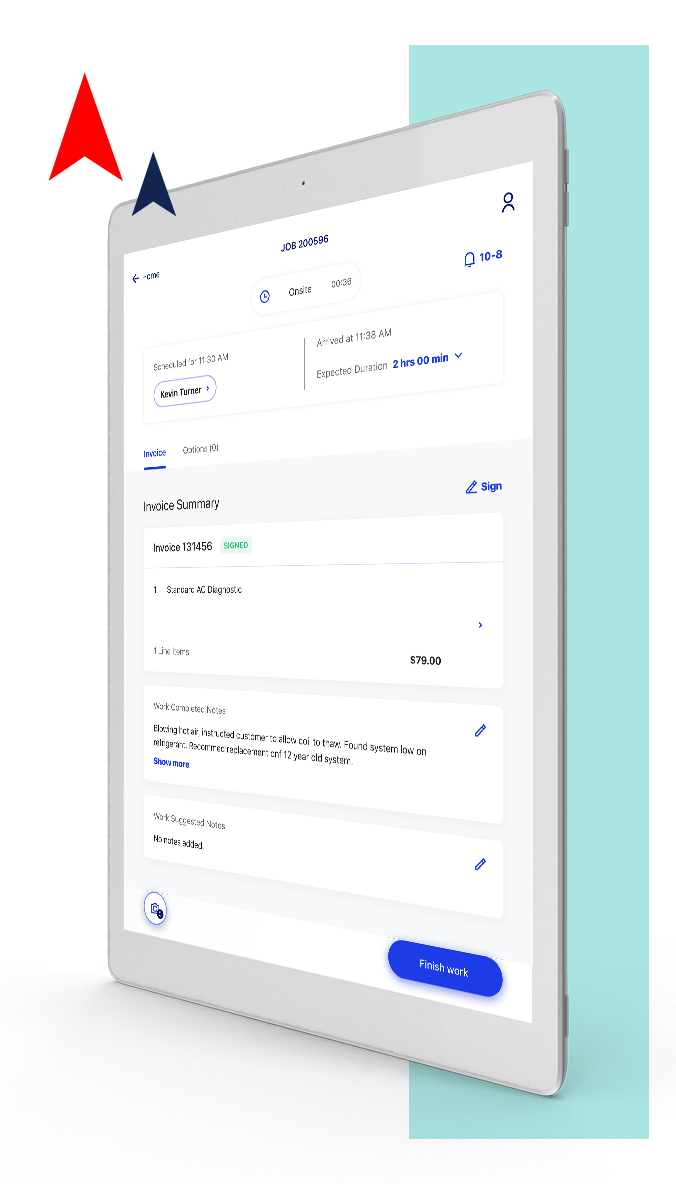How to Grow a Home Service Business with the Right Software Solutions
Each industry niche presents its own additional challenges, such as seasonal demand fluctuations and keeping up with the latest regulations and technical advancements in the field. Business owners also go up against a unique set of competitors, and the lessons learned by competing in one area don’t always translate directly to other territories.
In other words, there’s no one-size-fits-all solution for growing a service business.
To help you weather these challenges, we’ve assembled a list of our best small business growth strategies with a specific focus on the trade industries.
What’s the Average Small Business Growth Rate?
The average small business growth rate is 7-8 percent per year. This may seem like slow growth, but it’s also sustainable. A company with a 15% annual growth rate will double in size in five years. Faster growth than this presents numerous challenges that many small businesses will struggle to keep up with.
With the right team and technology in place, implementing sustainable business growth strategies should be manageable. Cementing your company’s healthy future is within reach!
Small Business Growth Strategies
Nail Down the Basics
To start making growth plans, start with a solid foundation:
- A clear scope of work you can provide to customers.
- A team of reliable employees who have the tools they need to do their job right and are united behind you in striving for business growth.
- A user-friendly website that loads fast and makes it easy for people to find the information they need.
- An optimized Google Business Profile listing that includes accurate contact information. (Bonus points for robust and accurate Bing Places and Apple Maps listings!)
- Any other marketing collateral that’s essential for promoting brand awareness and leads.
- Booking and back-office tools that make daily work manageable.
Focus on Customer Service and Retention
Besides performing reliable home repairs and installations, there’s probably nothing more important to a home service company’s success than providing good customer service. The impression your staff makes upon customers plays a big part in your company’s reputation. Plus, satisfied customers are most likely to recommend your services to their network!
When it comes to leveraging technology for business growth, one of the smartest places to start is automating time-consuming tasks, including some customer service processes. For example, email marketing tools make it easy to stay in front of current customers and nurture new leads with less effort.
These tools can automatically:
- Send a follow-up email after an appointment to ensure customer satisfaction, remind them of future repair needs or scheduled appointments, and ask them to leave a review for your company.
- Enter new customers and prospects into automated drip email campaigns, which effortlessly nurture those leads until they’re ready to become customers.
- Alert leads and customers to seasonal services, special offers, and news about your company.
Another excellent customer service tactic is to offer consumer financing. Such programs make it easier for your customers to fit major installations and repairs into their budgets.
Develop Marketing Strategies and Tactics
Technology can also make it easier to develop marketing strategies and tactics to grow your business. These are good customer acquisition strategies to start with that will provide the best bang for your buck:
- Segment your customer list in your customer relationship management tool (CRM) to develop personalized messaging. Personalization is critical for marketing success; 73% of consumers prefer to buy from brands that send personalized emails.
- Ask your technicians what questions property owners tend to ask most often and write informative blog posts that answer those questions. Write for your customers first, then apply search engine optimization (SEO) tactics to attract organic traffic to the blog. Consider adding those questions and answers to your Google Business Profile too.
- Paid media marketing (such as pay-per-click [PPC] advertising) can be an excellent customer acquisition strategy. To successfully drive leads with paid media, you need to know where prospects are in the decision-making process and understand how these people are most likely to find you. PPC typically requires constant monitoring and tweaking to achieve consistently good results; one exception is Google Guaranteed. Once you are Google Guaranteed, you can run Local Service Ads, which are a fantastic set-it-and-forget-it lead-gen tool!
Understand Finances to Make Smart Money Moves
Gaining a solid understanding of your company’s financial health can be painful, but it’s necessary to establish realistic goals that will set you up for sustainable growth. From there, you can develop a budget that ensures stability but also allows you to invest in the resources you’ll need to expand operations. If the person in charge of your company’s money implements the financial management strategies, they can work to ensure your company adheres to the new budget.
Improve Operational Efficiency with the Right Field Management Tool
Do you still handle your field service management in an Excel spreadsheet, or even with pen and paper? If you only have one or two technicians working each day, that probably works just fine. But when your company expands to include more techs and vans on the road, you’ll need a better system to achieve dispatching efficiency.
A good field service management tool will:
- Make technician scheduling and dispatching easier for your office staff.
- Ensure that the closest, most qualified people are sent to handle house calls.
- Maximize technician time and vehicle fuel efficiency.
- Minimize wear and tear on vehicles.
- Determine what causes callbacks and implement additional training for those who need it.
- Provide consistently excellent customer service through on-time arrivals, successful service calls, and reduced callbacks.
Monitor Operational Efficiency Metrics & KPIs
Technology is also critical to assessing the success of your business growth strategies, measuring operational efficiency, and adjusting accordingly. The first step to making all this data work for you is establishing key performance indicators (KPIs) and performance measurement standards.
We recommend starting with:
- Revenue: Measure monthly revenue against the same month in the previous year to control for seasonal demand fluctuations.
- Expenses: When examining expenses, keep in mind changes in staffing, necessary equipment upgrades, inflation, and any other spending that may differ from year to year.
- Close rate: When a lead call comes in, how often does your team successfully book an appointment with that lead? There are lots of things you can do to improve this number; consider providing call scripts, phone etiquette training, and monthly incentives for those with the best close rate.
- Average customer acquisition cost (CAC) and average customer lifetime value (CLTV): Compare CAC to CLTV to measure how effective your marketing strategies have been.
- How stable and predictable is profitability?: This metric will be an important indicator of whether your company is ready to expand.
Looking for a single tool that helps you accomplish all of this and more? Request a Successware demo today.
The Next Step: Small Business Expansion Strategies
Once your processes and systems are ironed out and the company is consistently meeting its goals, it’s time to focus further into the future.
Expansion is a critical phase of a company’s growth that demands strategic planning and execution. Several actions can be instrumental in propelling long-term business growth:
- Diversify products or services. By introducing complementary offerings or targeting new customer segments (adding commercial clients, for example), a small home service business can tap into fresh revenue streams. This is a great way to diversify your revenue streams and potentially broaden your customer base.
- Collaborate and partner with like-minded enterprises. This can lead to shared resources, expanded market reach, and new prospective customers. Strategic alliances can also amplify your brand's visibility and credibility.
- Master effective marketing and branding strategies to attract and retain customers. A compelling online presence through a user-friendly website, active social media engagement, and targeted advertising can significantly boost visibility and customer acquisition.
- Provide exceptional customer service. Satisfied customers are more likely to become brand advocates, driving growth through referrals and reviews. After all, word-of-mouth is one of the most effective customer acquisition techniques out there.
- Strategically embrace technology. Implementing efficient back office management systems, adopting e-booking platforms, and using data analytics to make informed business decisions are key to staying competitive and scalable.
Special Considerations by Industry
In addition to all the above recommendations, there are some industry-specific recommendations to keep in mind when developing a business growth plan.
HVAC Business Growth
Diversification is going to be crucial for HVAC service companies. Homeowners are moving toward more energy-efficient heating and cooling options, so make sure your technicians are trained and certified to install and service as many of those new systems as possible. There’s an increasing emphasis on air-source heat pumps, smart thermostats, energy recovery systems, geothermal, and more renewable energy sources that are growing in awareness and demand.
Indoor air quality is another area growing in popularity. Get your staff trained on air purifier systems and next-generation air filters. Service providers in many regions should expect to install fewer gas-powered HVAC systems over the next several years, as electric systems are more thermally efficient and sustainable, and pose no risk of carbon monoxide poisoning.
A third potential service to consider offering is home insulation and sealing, which now comes with federal incentives for local homeowners. Eliminating drafts and beefing up a home’s insulation will make those repaired or newly installed HVAC systems even more energy efficient. If homeowners can hire your company to perform both services, you’ll save them hassles and earn additional revenue while meeting their home comfort needs.
Electrical Business Growth
With a growing emphasis on energy efficiency, electrical service companies should expect big shifts within the industry. Experts are encouraging us to move away from fossil fuels, and tax incentives available through the Inflation Reduction Act make it more affordable than ever for homeowners to make the shift to all-electric appliances.
High home prices and interest rates have many homeowners staying put instead of buying bigger, newer homes. People with houses that are a few decades old (or more) will be looking for ways to upgrade their current homes. For many, this will mean upgrading their electrical panel to 200 amp service to accommodate modern electronics and appliances. While some regions lend themselves to residential solar better than others, the overall residential solar market is expected to grow about 15% annually through 2030. Many dedicated solar installers contract with local licensed electricians to perform the most complicated electrical work. And many local electricians are beginning to offer services for home backup battery installation.
Industry observers predict that electric cars and plug-in hybrids will claim 40-50% of new car sales in the US by 2030, and all those owners will need Level 2 home chargers installed in their garages or carports to charge their EVs quickly and efficiently at home.
The more of these specialty services you can offer to customers, the better foothold you’ll have in a rapidly expanding space.
Plumbing Business Growth
The move toward eco-friendly, money-saving options extends to the plumbing industry. Tankless water heaters have been gaining popularity for years, and that trend will continue. Greywater recycling systems have been used in commercial applications for some time, and residential systems are also gaining traction. Drain-water heat recovery systems are another home plumbing upgrade that’s expected to become much more common in homes in the coming years. Hybrid water heaters, also known as heat pump water heaters, now come with federal tax incentives and are starting to become popular with homeowners as an environmentally responsible choice that halves their monthly water heating bill. And just as we’re seeing with HVAC, electric plumbing appliances don’t pose a carbon monoxide poisoning risk and are considered more sustainable than gas-fired devices.
The 2020 pandemic opened people’s eyes to the importance of maintaining a clean living environment. As a result, touchless faucets in residential kitchens and bathrooms have been gaining popularity for a few years. The toilet paper shortage of 2020 also caused an increase in the popularity of bidets, which Americans have historically shunned. All that to say, get your technicians ready to install and repair a wider range of plumbing fixtures in the future.
How Successware Can Support Your Small Business Growth Goals
If you’re searching for a single tool that will help your company reduce expenses, increase revenue, and streamline business management processes, Successware can help. Our platform is the perfect solution for small to medium-sized HVAC, electrical, and plumbing service companies that are looking for ways to level up.
Learn how Successware can help you achieve your business growth goals. Request your Successware demo today.






.1)[1].png)
.png)
[1].png)
[1].png)
[1].png)



